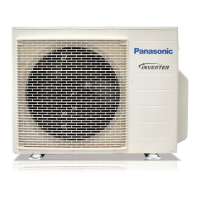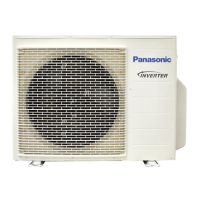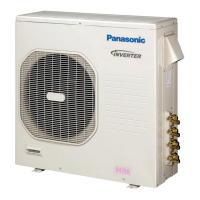Why my Panasonic CU-3E18PBE makes cracking sound?
- RrollinsjacobAug 30, 2025
A cracking sound during operation of your Panasonic Air Conditioner is due to temperature changes causing the expansion or contraction of the unit.
Why my Panasonic CU-3E18PBE makes cracking sound?
A cracking sound during operation of your Panasonic Air Conditioner is due to temperature changes causing the expansion or contraction of the unit.
Why does my Panasonic CU-3E18PBE Air Conditioner's outdoor unit emit water or steam?
The emission of water or steam from the outdoor unit is due to condensation or evaporation occurring on the pipes.
Why does mist emerge from my Panasonic Air Conditioner's indoor unit?
The mist that emerges from your Panasonic Air Conditioner's indoor unit is a condensation effect due to the cooling process.
Why does mist emerge from the indoor unit of my Panasonic CU-3E18PBE Air Conditioner?
The mist emerging from the indoor unit is a condensation effect resulting from the cooling process.
Why does the POWER indicator blink before I turn on my Panasonic CU-3E18PBE Air Conditioner?
The POWER indicator blinking before your Panasonic Air Conditioner is switched on is a preliminary step in preparation for operation when the ON timer has been set.
How to fix a Panasonic CU-3E18PBE remote control that is not working?
If your Panasonic Air Conditioner remote control isn't working, ensure that you have inserted the batteries correctly or replace the weak batteries.
Why does the indoor fan stop during heating in my Panasonic CU-3E18PBE Air Conditioner?
The indoor fan in your Panasonic Air Conditioner stops occasionally during heating operation to avoid an unintended cooling effect.
Why does airflow continue after my Panasonic CU-3E18PBE is turned off?
Airflow continuing after the operation has stopped on your Panasonic Air Conditioner is due to the extraction of remaining heat from the indoor unit, which can take up to 30 seconds.
How to improve HEAT/COOL mode efficiency in Panasonic CU-3E18PBE Air Conditioner?
If the HEAT or COOL mode on your Panasonic Air Conditioner isn't working efficiently, ensure the temperature is set correctly. Also, close all doors and windows, clean or replace the filters, and clear any obstructions at the air inlet and outlet vents.
Why POWER indicator blinks during HEAT mode on Panasonic Air Conditioner?
If the POWER indicator on your Panasonic Air Conditioner blinks during HEAT mode and there's no warm air, with the flap closed, it means the unit is in defrost mode and AIR SWING is set to AUTO.
Warnings and cautions regarding appliance use, injury, and property damage.
Safety precautions for remote control, Network Adaptor, and power supply.
Warning about the risks associated with flammable refrigerant R32.
Requirements for personnel handling refrigerants and safety for refrigerating circuits.
Guidelines for installation space, piping protection, and compliance with regulations.
Requirements for service personnel and safety procedures before starting work.
Procedures for checking refrigerant, fire extinguishers, ignition sources, and ventilation.
Checks for refrigerating equipment, electrical components, and earth bonding.
Safety for component repair, cabling, and flammable refrigerant detection.
Acceptable leak detection methods and procedures for refrigerant removal.
Procedures for charging refrigerant and decommissioning the equipment.
Requirements for labelling and recovering refrigerant safely.
Instructions on how to retrieve and interpret error codes displayed by the unit.
Conditions requiring consultation with an authorized dealer for service.
Warnings and cautions regarding appliance use, injury, and property damage.
Safety precautions for remote control, Network Adaptor, and power supply.
Warning about the risks associated with flammable refrigerant R32.
Requirements for personnel handling refrigerants and safety for refrigerating circuits.
Guidelines for installation space, piping protection, and compliance with regulations.
Requirements for service personnel and safety procedures before starting work.
Procedures for checking refrigerant, fire extinguishers, ignition sources, and ventilation.
Checks for refrigerating equipment, electrical components, and earth bonding.
Safety for component repair, cabling, and flammable refrigerant detection.
Acceptable leak detection methods and procedures for refrigerant removal.
Procedures for charging refrigerant and decommissioning the equipment.
Requirements for labelling and recovering refrigerant safely.
Instructions on how to retrieve and interpret error codes displayed by the unit.
Conditions requiring consultation with an authorized dealer for service.
| Outdoor unit weight | 71000 g |
|---|---|
| Outdoor units quantity | 1 |
| Outdoor unit noise level | 47 dB |
| Outdoor unit dimensions (WxDxH) | 875 x 320 x 795 mm |
| Type | Air conditioner outdoor unit |
| Ionizer | No |
| Inverter technology | Yes |
| Refrigerating medium | R410A |
| Cooling capacity (max) | 18000 BTU/h |
| Air conditioner functions | Cooling, Heating |
| Cooling capacity in watts (max) | 7300 W |
| Cooling capacity in watts (min) | 1800 W |
| Heating capacity in watts (max) | 8300 W |
| Heating capacity in watts (min) | 1600 W |
| Cooling energy efficiency (EER, W/W) | 4.33 |
| Heating energy efficiency (COP, W/W) | 4.69 |
| Seasonal efficiency rating (cooling) (SEER) | 7 |
| Seasonal efficiency rating (heating) (SCOP) (Average heating season) | 4 |
| Noise level | 61 dB |
| Power consumption (cooling) (max) | - W |
| Power consumption (heating) (max) | 2110 W |
| Power consumption (heating) (min) | 320 W |
| Annual energy consumption (cooling) | 260 kWh |
| Annual energy consumption (heating) (Average heating season) | 1680 kWh |












